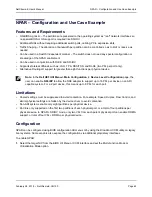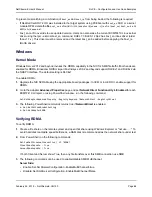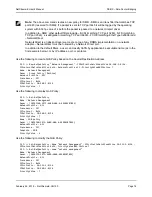
DCBX – Data Center Bridging
NetXtreme-E User’s Manual
February 26, 2018 • NetXtreme-E-UG100
Page 76
Use the following to create QoS Policy based on the Source/Destination Address:
PS C:\> New-NetQosPolicy "Network Management" -IPDstPrefixMatchCondition 10.240.1.0/24 -
IPProtocolMatchCondition both -NetworkProfile all -PriorityValue8021Action 7
Name : Network Management
Owner : Group Policy (Machine)
Network Profile : All
Precedence : 127
IPProtocol : Both
IPDstPrefix : 10.240.1.0/24
PriorityValue : 7
Use the following to display QoS Policy:
PS C:\> Get-NetQosPolicy
Name : Network Management
Owner : (382ACFAD-1E73-46BD-A0A-6-4EE0E587B95)
NetworkProfile : All
Precedence : 127
IPProtocol : Both
IPDstPrefix : 10.240.1.0/24
PriorityValue : 7
Name : SMB policy
Owner : (382AFAD-1E73-46BD-A0A-6-4EE0E587B95)
NetworkProfile : All
Precedence : 127
Template : SMB
PriorityValue : 4
Use the following to modify the QoS Policy:
PS C:\> Set-NetqosPolicy -Name "Network Management" -IPSrcPrefixMatchCondition 10.235.2.0/24 -
IPProtocolMatchCondition both -PriorityValue802.1Action 7
PS C:\> Get-NetQosPolicy -name "network management"
Name : Network Management
Owner : {382ACFD-1E73-46BD-A0A0-4EE0E587B95}
NetworkProfile : All
Precedence : 127
IPProtocol : Both
IPSrcPrefix : 10.235.2.0/24
IPDstPrefix : 10.240.1.0/24
PriorityValue : 7
Note:
The above command creates a new policy for SMB. –SMB is an inbox filter that matches TCP
port 445 (reserved for SMB). If a packet is sent to TCP port 445 it will be tagged by the operating
system with 802.1p value of 4 before the packet is passed to a network miniport driver.
In addition to –SMB, other default filters include –iSCSI (matching TCP port 3260), -NFS (matching
TCP port 2049), -LiveMigration (matching TCP port 6600), -FCOE (matching EtherType 0x8906) and
–NetworkDirect.
NetworkDirect is an abstract layer we create on top of any RDMA implementation on a network
adapter. –NetworkDirect must be followed by a Network Direct port.
In addition to the default filters, a user can classify traffic by application’s executable name (as in the
first example below), or by IP address, port, or protocol.
















